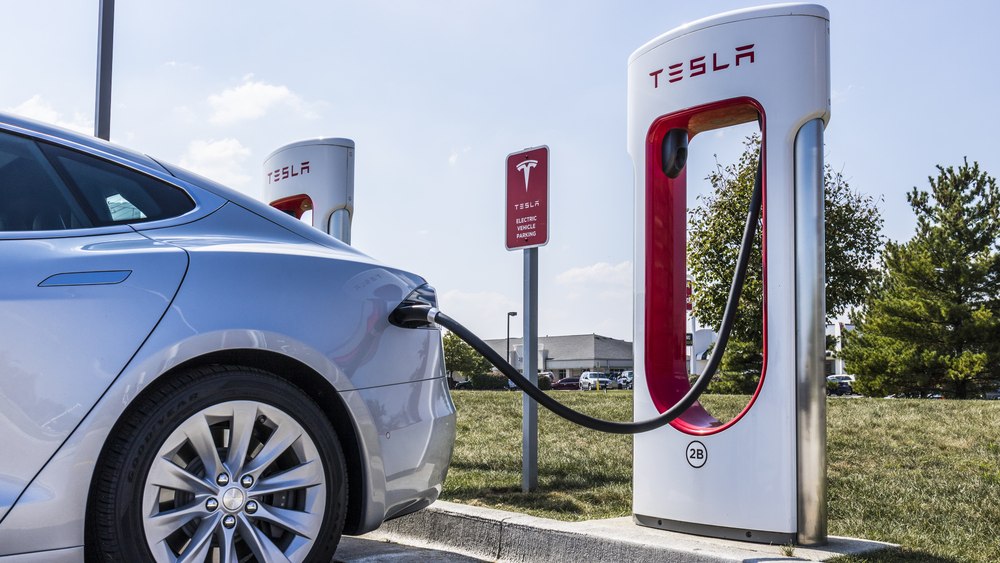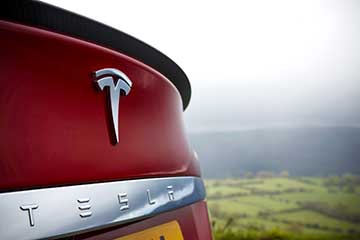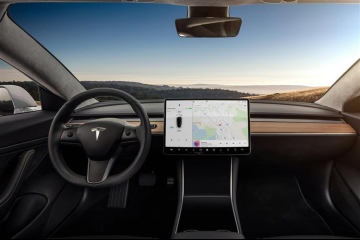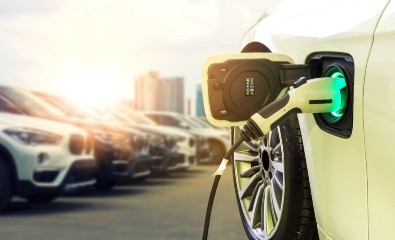If you’ve been out and about travelling on the motorway and main roads network of the UK, chances are you’ve seen charging posts for electric cars known as ‘Superchargers’. But what exactly is it? How powerful are these Tesla Superchargers, and can any EV driver use them? Read on to find out more...
In This Article:
What Is A Tesla Supercharger? How Fast Are Superchargers? How Much Does Tesla Supercharging Cost? How Many Types Of Supercharger Are There? How Do I Use A Tesla Supercharger Are Superchargers Open 24 Hours A Day? Do Tesla Superchargers Run Fast To 100% Battery Charge? Does Repeated Supercharger Use Affect A Tesla’s Battery Pack? what Are Idle Fees? Are Tesla Superchargers Safe To Use In All Weathers? Can Other Electric Cars Use Tesla Superchargers?
What Is A Tesla Supercharger?
The Supercharger network is the proprietary charging system for the American electric cars. The giveaway is the huge ‘TESLA’ logo at the branded across the top of every one of the charging units. That’s right, unless you have a Tesla of some sort, at the moment you can’t hook up to a Supercharger and get electricity for your vehicle from it… but that could change in the future, as CEO and general megalomaniac Elon Musk has said he is planning to open up the Supercharger network to non-Teslas in the future. We shall wait to see how this develops in Europe.
So, now we’ve got that disappointment out of the way, then if you DO have a Tesla you can take advantage of the Superchargers. They are basically the rapid public charging network for Tesla cars, with speeds of up to 250kW DC possible. They’re easy to spot – Tesla Superchargers are normally white with red detailing, making them look unlike any other EV charging point, and as we’ve already said they’re branded ‘TESLA’ so there’s no ambiguity about precisely what they are.
How Fast Are Superchargers?
Using 480-volt technology, Superchargers are pretty fast and if you find a V3 running at 250kW, you’ll be on your way again in a matter of minutes after a charging session begins. Basically, at maximum speed, a 10-80% charge on a Supercharger will take around 31 minutes for a Model Y, rising to 38 minutes for a Model S or X with the 100kWh battery pack. You’ll be looking at more like an hour for the same charge on an older V1 or V2 running at 150kW.
How Much Does Tesla Supercharging Cost?
For some of the earliest adopters of the Model S, Tesla actually gave drivers free Supercharger access as part of the car purchase. However, that trend has stopped on newer models, but Superchargers are normally fairly consistent in their pence-per-kilowatt-hour (kWh) rate, although it can vary from location to location.
Tesla drivers have an app so they don’t need to pay at the Superchargers themselves – they simply plug in and then they’re billed at the appropriate rate for however much charge they took onboard. Tesla’s rates are split into 2: Tier 1 applies when the cars are charging at 60kW or less, or are hooked up to a Supercharger with another Tesla sharing the electricity, while Tier 2 is for any charging rate above 60kW. Tier 2, neatly enough, is twice as expensive as Tier 1, and Tesla charges customers in the main on a ‘per kWh’ basis, although there are areas where the service is billed per minute of connection.
You can also find that certain Supercharger stations offer on- and off-peak rates, and Tesla’s live map of UK Supercharger locations plus the satnav in every Tesla will display what the rates are and when the peak times for charging are at any given location.
How Many Types Of Supercharger Are There?
There are 3 types of Tesla Supercharger, known as the V1, V2 and – yes – the V3. All of them should be able to support charging 2 cars at one go, but there are normally enough banks of Tesla Superchargers at any 1 location that the etiquette is you should go on another charging unit which is free, rather than park next to another Tesla and hook up to the same unit – unless, of course, it’s so busy there aren’t any free Superchargers left.
As Teslas themselves have had different charging mechanisms over the years – the early Model S and Model X cars are different to the later Model 3 and Model Y vehicles, and later versions of the Model S and Model X too – then there are normally 2 different connectors. Of these, 1 will be a straightforward Type 2 7-pin connector for the older cars, and then there’ll be something which looks like a CCS Combo 2 connector for newer Teslas – this doesn’t have as many pins inside it, though, as the CCS Combo 2 standard used on most other EVs from other manufacturers.
V1 and V2 Superchargers can run at a maximum 150kW DC if there’s only 1 car attached, while more advanced V3 chargers go up to 250kW. As soon as a 2nd Tesla connects to any Supercharger that is already in use, however, the maximum charging rate could decrease on the 1st car, although the 1st car’s charging rate is prioritised. Charging rates also vary for 1 car hooked up to a Tesla Supercharger, depending on the climatic conditions, the state of charge of the vehicle’s battery and so on – so don’t always expect 250kW from a V3 charger, for example, even if you’re on it on your own.
How Do I Use A Tesla Supercharger
Simplicity itself. Because Tesla owners are registered through an app and the electricity charges are automatically sent to them via their preferred method of contact, there’s no need to pay on site at a Supercharger. So you simply drive up to a vacant charging unit, hook up the relevant cable and power begins to flow into the car. A green LED in the vehicle’s charge port glows to indicate the car is taking in electricity.
Are Superchargers Open 24 Hours A Day?
In the UK, for the vast majority of the 780 charging units located at 87 different locations across the UK (as at the end of 2021), then yes – they’re available 24/7. Naturally, some of the independent facilities that are near to Tesla Supercharger units aren’t always open 24 hours a day as well, so it might be that you can’t go and get a convenient cup of coffee while you’re waiting for the car to juice itself back up, if it happens to be 3am or something. But you should always be able to get power from the Supercharger, at the least.
Do Tesla Superchargers Run Fast To 100% Battery Charge?
Nope, like all DC EV charging points, Superchargers start to slow the maximum rate of charge once the battery has reached 80% of its capacity, in order to preserve the long-term life of the battery pack. By 95%, Tesla advises that its Superchargers will be running slower than charging the car at home on an AC connection, and at 98% the charge rate drops to an almost negligible level so it is not worth hanging on for 100%. Tesla EVs tend to have long ranges on them, so 80% charge should easily see you to another Supercharger location further along your intended route, or alternatively it will get you to your final destination – be that home or another address.
Does Repeated Supercharger Use Affect A Tesla’s Battery Pack?
Like any EV, Tesla recommends regular home charging on an AC connection as a way of prolonging the battery life of its vehicles. Rapid DC charging, if used solely as the way of getting electric into an EV, does not do the battery’s health any good in the long term, so only use Tesla Superchargers when you’re going on a long journey or you are unexpectedly down to a very low level of charge in your battery. Otherwise, try and plan routes that allow for ‘destination’ charging on AC, either at your place of residence or work.
What Are Idle Fees?
Tesla has instigated a system whereby it prevents owners ‘hogging’ Superchargers at busy times. It limits the maximum charge level for any given car to 80% if more than 50% of the Supercharger units at a given location are in use by other vehicles, and then you get hit with idle fees if you ignore this limit and keep your car in a charging bay after 5 minutes beyond the end of the charging session have elapsed.
This is to stop people hooking their cars up and just leaving them there for hours on end while they go off to do something else. So, once the 5 minutes of grace period has elapsed, you are then charged around 30p per minute of idle fees for every minute you keep your Tesla connected to the Supercharger. Therefore, for example, if you stay there 15 minutes after the car has reached its 80% charge limit at a busy Supercharger location, you will incur idle fees of £3 for the additional 10 minutes you stayed on the charger after the 5-minute buffer zone had elapsed. Regular charging update notifications sent through the Tesla app should prevent owners from falling foul of idle fees, though.
Are Tesla Superchargers Safe To Use In All Weathers?
Yes, like all EVs, the charging system has been weatherproofed so that you can top up your vehicle come rain, wind or snow.
Can Other Electric Cars Use Tesla Superchargers?
Not as yet, but a trial in the Netherlands in 2021 saw various Superchargers opened up to non-Tesla EVs, while Norway – one of Tesla’s key world markets – has insisted that the Supercharger network there cannot be ‘exclusive-use’. So hopefully, the expansion of the Superchargers’ benefits to all EV owners will come into force in Europe sooner rather than later.
For more articles, you can check out our car features and guides section. Or if you're looking for a brand new vehicle, we've got a huge range of cars to lease at unbeatable prices.





